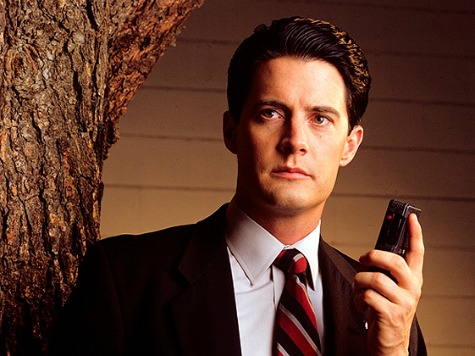“People talk about this or that show being a groundbreaking pilot. Well, let me show you a groundbreaking pilot,” says Robert Engels, one of the original members of the Twin Peaks writing staff.
I caught up with Engels recently over lunch at Burbank’s Bob’s Big Bo to discuss his recollections of the famous television series. The complete saga of Mark Frost & David Lynch’s mysterious town is released on Blu-ray later this month, including 90 minutes of deleted scenes.
Engels was a neophyte screenwriter at the time of the show’s creation. He was taken under Frost’s tutelage, at the behest of Frost’s father, who was Engels’ college adviser.
“I was in New York, working as an actor and director. This was completely new to me. I mean, Mark taught me the format of a TV script. Breaking the show at his house was my training,” Engels says.
What emerged over the course of 30 episodes was a clarion call to American television. It was the first program since The Twilight Zone to impress the auteur theory upon American television audiences.
Engels is quick to credit Frost for much of the writing, a reminder that the show was truly a dual vision.
“He’s an incredibly gifted writer. He took a very simple structure, the soap opera, and infused with things people just hadn’t seen before.”
The scripts would then be steeped in trademark Lynchian weirdness, as Lynch would either direct himself, or choose from a very select group of helmers who had often worked with Lynch in other capacities. This included James Foley, Tina Rathborne, Tim Hunter, Duwayne Dunham, Diane Keaton, Caleb Deschanel, Lesli Linka Glatter, and several others.
Engels adds, with a laugh, “We’d get footage back from a shoot and there’d be a wheat field in someone’s living room, and we’d remark, ‘Gee, I don’t remember that being in the script’.”
Yet this Lynchian weirdness was, and still is, deeply rooted in Lynch’s cinematic approach. I asked if Lynch’s devotion to Transcendental Meditation may have come into play with Twin Peaks, as Lynch has referred to it as “diving into the subconscious.” Lynch is able, more than any other filmmaker, to create nightmare imagery that penetrates into and resonates with viewers. It often seems that he is able to tap into our collective nightmares.
Engels replied, “Maybe. I don’t know. For David, there’s often talk of how dreamy things are, and how ideas come from some other place. I know we all latched onto his creative process, and you see it with the casual pace and music of the show. It’s not rushed. It’s not forced.”
The mood and pacing are unquestionably tied to the show, yet they are part of a whole. Twin Peaks simply would not be the show it is without each element dovetailing with the others in a true cinematic symphony. It is this unity of vision that is one reason for the show’s success. Certainly the fact that this was a world viewers had never seen before is yet another reason.
However, the genius of Frost and Lynch was that the soap opera structure permitted them to draw clear lines between good and evil. There are no morally ambiguous characters floating through Twin Peaks. There are tragic ones, yes, like the wooden-knob-fated Josie Packard and Laura Palmer herself.
Otherwise, audiences are clear exactly what side of the fence the characters are on. Good or bad, however, we loved them all the same. In all likelihood, they each touch us in the same way the fright-fest of Windom Earle and the Black Lodge do – they are reflections of the collective unconscious brought to life.
Vanity (Ben Horne), Innocence (James Hurley), Feeling (Deputy Andy), Rage (Leo), Empathy (Norma), Evil (Windom Earle), and Chaos (BOB)-they are all represented in Twin Peaks.
This is yet another reason the show succeeded on levels that few modern shows do–the clear delineation between good and evil is why the show was surprisingly emotional. The revelation to both Leland and his wife of their daughter’s death is gut-wrenchingly real–this is what it would feel like for parents to learn of their daughter’s murder.
Maddy Ferguson’s murder occurs in a typically bravura Lynch-directed episode that somehow manages to be simultaneously mournful yet terrifying.
Engels has not seen the new Blu-ray release, but suspects a lot of footage belongs to the film prequel, Twin Peaks: Fire Walk With Me. The film was maligned at the time in many fan and critical circles and, in fact, I felt disappointed by it. However, repeat viewings have proven to be tremendously rewarding.
Engels agrees with my assessment that this was the first film since Eraserhead where Lynch stretched more into experimental, non-linear narrative, setting the stage for his subsequent work.
Begin Spoiler Alert…
Viewers are so enamored with the strange doings of Twin Peaks that they forget that, at its core, this is a story of a young woman’s victimization by incest. When viewed through this lens–through Laura Palmer’s lens–the nightmare imagery and terrifying struggle between good and evil make much more sense.
Armed with this information, the film offers so much more, with the bizarre structure and frightening non-linear dream sequences making much more sense. It isn’t even intellectual sense I refer to, but something profoundly visceral.
That is the genius of Lynch.
Twin Peaks: The Entire Mystery will be available July 29, 2014.

COMMENTS
Please let us know if you're having issues with commenting.